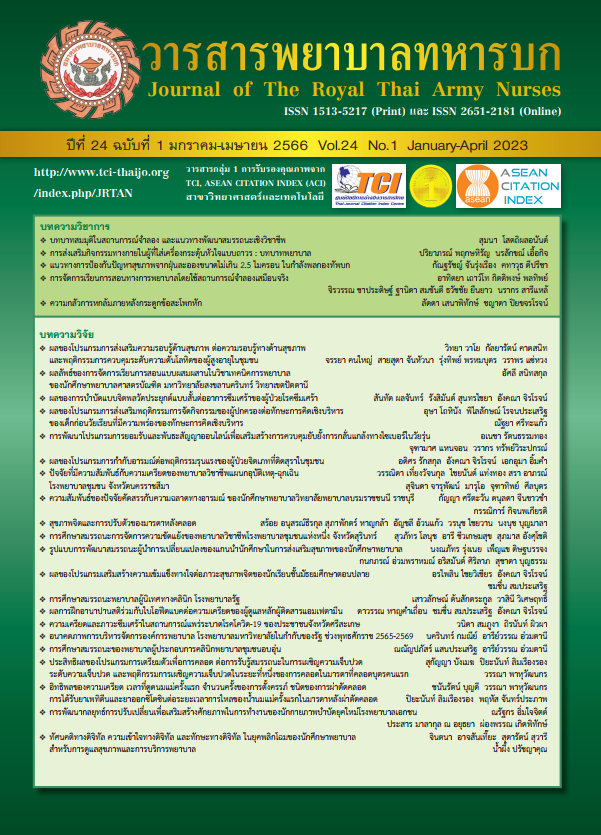The Management of Teaching and Tearning in Nursing by Using Virtual Reality Simulations
Keywords:
Realistic nursing simulations, Nursing science curriculumAbstract
A teaching and learning management in the nursing science curriculum by using realistic nursing simulations is a teaching and learning management in the changing situation of global society technology. In order for students to gain experience instead of real situation. There is 5 step leaning process: 1) Before teaching 2) Introduction 3) The Simulation experience 4) Debriefing and 5) Evaluation. There are simulators to choose from as appropriate. These things result in the development of learning outcome for the students and increase teaching skills for teachers. However, the teachers must choose and apply to suit the course and different situations to achieve the objectives of learning and creating experience for the learners. This article will build understanding of instructional management by using virtual simulations to further design nursing instruction.
Downloads
References
Wheeler, D. S., et al. High-reliability emergency response teams in the hospital: Improving quality and safety using in situ simulation training. BMJ Quality & Safety 2013;22: 507-14.
Kathleen M. Ventre, Howard A. Schwid. Computer and Web-Based Simulators. In: Adam IL, Samuel D, editors. The Comprehensive Textbook of Healthcare Simulation. Sim Editors Springer Science Business Media, New York, 2013: 191-208.
SharonDecker.FoundationsofSimulation.In:Beth TL, Mary EM, editors. Mastering Simulation: A Handbook for Success. Indianapolis,IN, 2014: 1-21.
Ellaway RH, Kneebone R, Lachapelle K, Topps D. Practical continua: Connecting and combining simulation modalities for integrated teaching, learning, andassessment. Medical Technologies Journal 2009; 8:725-31.
Cooper JB, Taqueti VR. A Brief History of the Development of Mannequin Simulators for Clinical Education and Training. Quality & Safety in Health Care, 2004;13(Suppl 1): i11–18.
Adam I. Levine., et al. The Comprehensive Textbook of Healthcare Simulation. Sim Editors Springer Science Business Media, New York, 2013.
Teresa G., Global Perspective for Integrating Simulation Across the Curriculum INACSL Standards of Best Practice: Simulation Design, 2015.
Ashley E. Franklin. Standards of Best Practice: Simulation Standard IV: Facilitation. Clinical Simulation in Nursing 2013;9: 19-21.
Fanning, R.M. & Gaba, D.M. The role of debriefing in simulation-based learning. Simulation in Healthcare 2007;2: 115-25.
Rudolph, J. W., Simon, R., Raemer, D. B., & Eppich, W. J. Debriefing as formative assessment: closing performance gaps in medical education. The Society for Academic Emergency Medicine 2008;15: 1010–1016.
Katie A. Adamson. Evaluating Simulation Effectiveness. In: Beth TL, Mary EM, editors. Mastering Simulation: A Handbook for Success. Indianapolis, IN, 2014: 143-56.
Benjamin Berg. High Stake Evaluation. Academy Colloquium, SimTiKi Simulation Center, University of Hawaii, 2017.
Chad Epps. Mannequin-Based Simulators. In: Adam IL, Samuel D, editors. The Comprehensive Textbook of Healthcare Simulation. Sim Editors Springer Science Business Media, New York, 2013: 209-31.
Ryan Owens and Jeffrey M. Taekman. Virtual Reality, Haptic Simulators, and Virtual Environments. In: Adam IL, Samuel D, editors. The Comprehensive Textbook of Healthcare Simulation. Sim Editors Springer Science Business Media, New York, 2013: 233-53.
Lisa D. Howley. Standardized Patients. In: Adam IL, Samuel D, editors. The Comprehensive Textbook of Healthcare Simulation. Sim Editors Springer Science Business Media, New York, 2013: 173-90.
Valerie M. Howard. Creating Effective, EvidenceBased Scenarios. In: Beth TL, Mary EM, editors. Mastering Simulation: A Handbook for Success. Indianapolis, IN, 2014: 87-123.
Thamnamsin K., Punyapet K., Noitung S. and Artsanthia J.. The effect of teaching simulation-based learning program to the knowledge in basic medical care of nursing students. Journal of The Royal Thai Army Nurse. 2018. 19(Supp.): 80-8. (in Thai)
Lertlum L., Tanasansutee C., Panawatthanapisuit S. and Bamrungsri C. Development of a simulation-based learning model. The Southern College Network Journal of Nursing and Public Health. 2019.6(Special): 43-58. (in Thai)
Winitchai N. Effect of learning management toward using program simulation instructional media for injection on satisfaction of 2nd year nursing student. Journal of Nursing and Health Sciences. 2021. 15(1): 115-26. (in Thai)
Kim Leighton. Simulation in Nursing. In: Adam IL, Samuel D, editors. The Comprehensive Textbook of Healthcare Simulation. Sim Editors Springer Science Business Media, New York, 2013: 425-36.
Downloads
Published
How to Cite
Issue
Section
License
Copyright (c) 2023 Journal of The Royal Thai Army Nurses

This work is licensed under a Creative Commons Attribution-NonCommercial-NoDerivatives 4.0 International License.
บทความหรือข้อคิดเห็นใดใดที่ปรากฏในวารสารพยาบาลทหารบกเป็นวรรณกรรมของผู้เขียน ซึ่งบรรณาธิการหรือสมาคมพยาบาลทหารบก ไม่จำเป็นต้องเห็นด้วย
บทความที่ได้รับการตีพิมพ์เป็นลิขสิทธิ์ของวารสารพยาบาลทหารบก
The ideas and opinions expressed in the Journal of The Royal Thai Army Nurses are those of the authors and not necessarily those
of the editor or Royal Thai Army Nurses Association.






